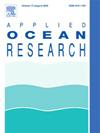基于cfd的集装箱船新型减阻附件设计
IF 4.3
2区 工程技术
Q1 ENGINEERING, OCEAN
引用次数: 0
摘要
集装箱船作为现代全球贸易的基石,近年来集装箱船的规模显著增加。这种增长需要最大限度地减少对环境力量的阻力,以提高可操作性,增强安全性,并减少燃料消耗。传统的空气动力学优化主要集中在挡风玻璃和集装箱堆垛结构上,而本研究引入了一种受运动空气动力学工程启发的新型减阻附件。这项研究分为两个阶段。首先,将数值模型与实验风洞结果进行了验证,在阻力系数差异小于2%的情况下实现了高度相关性。其次,将该模型应用于计算流体动力学(CFD)仿真,以评估各种附件设计的有效性。通过参数化研究,优化了附件的位置、尺寸和方向,两种配置分别实现了9.47%和9.22%的最大阻力降低。结果表明,这些附属物减轻了不利的压力影响,并简化了容纳块周围的流动,有效地减少了气动阻力。本研究证明了在不影响载货能力的情况下,集成简单、经济高效的附件来提高超巴拿马型集装箱船气动性能的可行性。研究结果为减少燃料消耗和排放提供了一种实用的方法,支持了可持续航运的持续努力。本文章由计算机程序翻译,如有差异,请以英文原文为准。
CFD-based design of novel drag-reducing appendages for container ships
Container ships, as cornerstones of modern global trade, have significantly increased in size in recent years. This growth necessitates minimizing resistance to environmental forces to improve operability, enhance safety, and reduce fuel consumption. While aerodynamic optimization has traditionally focused on windshields and container stacking configurations, this study introduces a novel drag-reducing appendage inspired by sports aerodynamics engineering. The research follows a two-stage approach. First, a numerical model was validated against experimental wind tunnel results, achieving a high correlation with less than a 2 % difference in drag coefficient. Second, the validated model was used in computational fluid dynamics (CFD) simulations to assess the effectiveness of various appendage designs. A parametric study was conducted to optimize appendage placement, size, and orientation, leading to two configurations that achieved maximum drag reductions of 9.47 % and 9.22 %, respectively. Results indicate that these appendages mitigate adverse pressure effects and streamline flow around the accommodation block, effectively reducing aerodynamic drag. This study demonstrates the feasibility of integrating simple, cost-effective appendages to enhance the aerodynamic performance of post-panamax container ships without compromising cargo capacity. The findings provide a practical approach for reducing fuel consumption and emissions, supporting ongoing efforts toward sustainable shipping.
求助全文
通过发布文献求助,成功后即可免费获取论文全文。
去求助
来源期刊

Applied Ocean Research
地学-工程:大洋
CiteScore
8.70
自引率
7.00%
发文量
316
审稿时长
59 days
期刊介绍:
The aim of Applied Ocean Research is to encourage the submission of papers that advance the state of knowledge in a range of topics relevant to ocean engineering.
 求助内容:
求助内容: 应助结果提醒方式:
应助结果提醒方式:


